Report 2: Research, Opportunities and Concepts
From DDL Wiki
Contents |
Research and Observations
After analyzing the current product, we decided to further study on what the user really want and need from a bicycle light set. To determine this we gathered our data through a survey that was distributed on a college campus, Carnegie Mellon University. In this section we will discuss the information we gathered, and our observation through these information.
Survey
By March 06, 2007 we had 84 respondents completed our surveys. 100 percent of our respondents are between the age group of 18 to 27 years old. About one third are females and two third are males. The followings are the few major questions that we had gain insightful information from.
1. Do you currently own a bicycle? (multiple choices, 84 respondents)
- Yes: 35.7%
- No: 60.7%
- No, but I am planning to purchase on: 3.6%
Note: 39.3 percent of respondents indicated that they either own or plan to own a bicycle. This demonstrates that there is a relative large market for bicycle and its accessories on a college campus.
2. How much did (will) you pay for your bicycle? (multiple choices, 84 respondents)
- $0-$50: 0%
- $51-$100: 10.7%
- $101-$150: 32.1%
- $151-$200: 14.3%
- $201-$300: 7.1%
- $301-$400: 3.6%
- $401-$600: 3.6%
- $601+ : 0%
- I never nor plan to own a bike: 25%
- Other: 3.6%
Note: 28.6 percent would or had purchased a bicycle for more than $151. This demonstrated that there is the financial capability of the students to purchase bicycle accessories.
3. Do you (plan to) ride your bike at night? If so, how often? (multiple choices, 84 respondents)
- Almost everyday: 10.7.%
- Few times a week: 14.3%
- Few times a month: 14.3%
- Few times a year: 13.7%
- Once every few years: 0%
- I don't nor plan to ride a bike: 47.0%
Note: A quarter of the respondent indicated that they ride their bike at least few times a week at night. This is a strong support to prove the need of a bicycle light set in the bicycle accessories market.
4. How appealing and feasible (willing to pay for) are the following features on a bicycle light set to you? (rating scale 1-5, 81 respondents)
- Self powered (power generates as you pedal): 3.92
- Power storing capacity (light can still be on even when not pedaling: 3.89
- Detachable feature to use the headlight as portable flashlight when need to or anti-theft reason: 3.68
- Compatible to charge the light with outlets: 3.50
- Ability to provide power output to charge electronic devices (ie. IPod): 3.67
- Charge indicator (display whether if the batter is fully charged or out of battery): 3.96
- Light-sensitive sensor (to turn on/off the lights): 3.68
- LED light bulbs: 3.54
- Florescent light bulbs: 3.00
- Radio: 2.93
- Digital Clock: 3.18
- Compass: 3.25
- Multiple flashing mode: 3.18
- Adjustable brightness feature: 3.70
- Steering handle mount headlight: 3.21
- Top of front wheel mount headlight: 3.30
- Adjustable light positions: 3.54
- Turn signals: 3.70
- Electrical horn: 3.11
Note: The top seven choices concluded from this survey are 1) Charge indicator 2) Power storing capacity 3) Self-powered generator 4) Adjustable brightness 5) Detachable feature 6) Light-sensitive sensor 7) Turn signals
In conclusion of our surveys, we were able to identify the need and want of a bicycle light set. In which reassured the direction of a generator powered bicycle light set is not only a engineered product but also a marketable product. In addition, we collected valuable information regarding the some of the new features that can be integrated in to the generator powered bicycle light set.
Observations
When observing the other bicycle light set in the market we have identified few technologies that are currently use by the competitors. We will discuss each of the following below.
Battery Powered
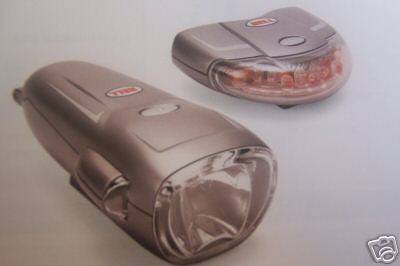
Wide use technology, depending on the specification of the components it can range from $4 to $600. Since, we are targeting the environmentally awared clients we would not consider this as a direct competition.
Hub Dynamo
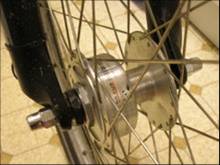
This technology integrates its dynamo into bicycle's front wheel. It requires a total replacement of front tire. However, it does have the advantage of not creating any additional friction for pedaling. Due to the replacement of major parts of bicycles, this technology usually cost between $100 and $300. Since our bicycle light set is targeting the price range of $20 to $100. We are competing for different segments of the market.
Bottom Bracket Dynamo
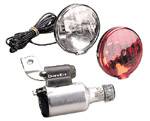
This technology is very similar to our technology "Bottle dynamo". The only major difference is that its generator is mounted between the bottom bracket (where you pedal) and your rear wheel. Its roller makes contact with the surface of the wheel rather than the profile. This technology is in direct competition with ours. However, it also experiences the same failure modes we do. Therefore, if we can improve our product we can significantly gain market shares.
Magnet Dynamo
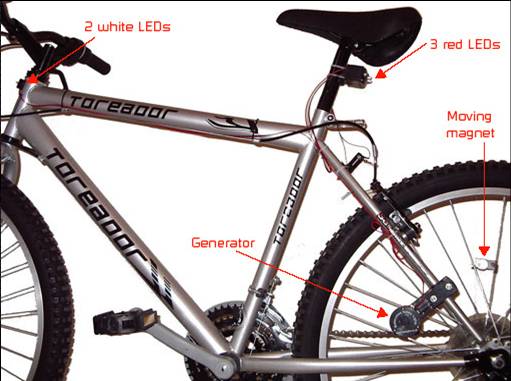
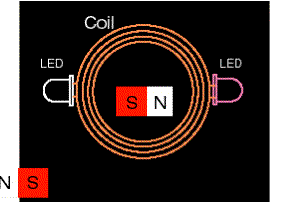
This is a different technology where its generator is not powered by any contact force. Rather, a magnet is mounted on the rim of the wheel and every time it moves pass the generator it pushes the built-in magnet in the generator to rotate. This product is simple and cheap, however it is not fully developed yet. If we can incorporate this in to our product we can reduce the pedaling friction caused by the generator and wear due to the roller.
50 Design Concepts
Installation
1. User manual
2. Wire organizing device (straps)
3. Provide simple installation tools
Mechanical
4. Use magnetic force to turn the generator
5. Low friction bearings
6. High traction roller (Different material: Rubber or metal; Different shape)
7. Transfer torque from the chain
8. Transfer torque from the pedal crank
9. Transfer torque from the wheel shaft
10. Adjustable spring for generator to provide efficient contact with wheel
11. Lightweight materials for generator
12. Rubber washers to reduce vibration noise
Electrical
13. Storing capacity (built-in rechargeable battery pack)
14. Voltage regulator (zener diode is an option)
15. Options to use over the counter batteries
16. Full circuit wiring (does not use the frame as a conductor)
17. Divide the power output to both front and rear lights
18. Deliver more current to front lights when in motion, and to the rear lights when stopped
19. Charge output feature
20. Light-sensitive sensor (to turn it on/off)
21. Multiple flashing modes and control switch
22. Multiple brightness levels and control switch
23. Power on/off switch
Mounting
24. Able to mount device on bicycles with shocks
25. Able to mount device on the steering handle
26. Universal mount for the generator
27. Adjustable lamp positions
28. Able to detach device with quick release switch
29. Mount the generator on top of the front wheel
30. Special mount for bicycle with basket in the front
31. Velcro mount
32. Magnetic mount
33. Slip-on mount
Lighting
34. Multiple LED light bulbs for extra brightness
35. Florescent light bulbs
36. Maximize ground coverage through angled arrangement of lights
37. Turn signals
Features
38. Charge indicator
39. Incorporate a compass on the device
40. Detachable to use as flashlight
41. Can be charge through power outlet
42. Anti-theft design
43. Warranty
44. Radio
45. Electrical honk
46. Digital clock
Exterior
47. Water resistant design
48. Fog resistant lens cover
49. Aerodynamic design
50. Different color selections
Design Problem and Opportunities
While our in first report had identified rooms for improvements in DMA, FMEA, and DFE we also gathered ideas from the customers through the survey concluded above, observed our competitor's design, and lastly, we generated a list of 50 ideas that the current product can possibly improve on.
After careful analysis on current design and comparing it with our competitors we conclude that for its price, it is very well designed. Its components are designed for mass production at low cost. To use the same design there is not much room for improvement. However, we do believe if we can revamp few of the major designs (ie. generator, mounting brackets) while adding a few more features it can attract many more customer base while still remaining relative low price.
Therefore, we hereby recommend the following design improvements:
1. Power Storage Ability
2. Fully Wired Closed Circuit
3. Detachability, Charge Indicator, Power Button
4. Chain-Mounted Generator
5. Turn Signal
We will discuss each design in detail in the following section.
Top Design Concepts
Design One | Power Storage Ability
Problem The generator stops when the bike is not in motion, cutting off the power delivery to the light. Thus putting the driver's safety at risk when he/she is about to cross a road in the dark.
Solution Power is harnessed from the generator to recharge a battery pack, and then electricity is delivered from the battery pack to the light.

Design Two | Fully Wired Closed Circuit
Problem Traditional generators use the bicycle frame to ground the circuit. However, many modern bicycles use composite materials that do not conduct electricity.
Solution A closed circuit is created with wires connecting to both the positive and negative terminals of all the components.

Design Three | Detachability, Charge Indicator, Power Button
Problem From our market survey, these features are preferred by most users.
Solution A power button and a charge indicator is added to the light. The light can be mounted on a fixture that is securely attached to the bicycle frame.

Design Four | Chain-Mounted Generator
Problem Traditional dynamos wear out tires and are prone to slip in water and debris.
Solution Although mechanically challenging, mounting the generator on the chain will solve the above problems, and in addition, maintain a stable voltage output.

Design Five | Turn Signal
Problem It is difficult to guess a rider’s intended direction of turning, even more difficult in the dark and in a distance.
Solution Divert power from the system to power up turn signal lights attached to multiple locations of bicycle.

Experimental Design Concept
After receiving feedback from the professor and the class during our presentation, we gained valuable insight on where to take our next step. In addition to our original proposed design concepts, we came up with a novel idea that was inspired by a question raised in class by a mechanical engineering student.
The following design concept is based on the existing technology of rotating a magnet with another magnet. This design we are proposing will implement that technology, in a more efficient and powerful way. For each rotation of the bicycle wheel, the rotating magnet will rotate multiple revolutions. The magnet-and-coil assembly will generate enough electricity to charge up the battery pack.

Pugh Chart
Value Opportunity Analysis
Low Medium High
Emotion
Adventure ***
Independence ************
Security ************
Sensuality
Confidence **************
Power ****************************
Ergonomics
Comfort ************************
Safety ************************
Ease of Use ******************************************
Aesthetics
Visual **************
Auditory ****************************
Tactile
Olfactory
Taste
Identity
Point in Time
Sense of Place
Personality ********
Impact
Social ********
Environmental ***************
Core Technology
Reliable ******************************************
Enabling ******************************************
Quality
Craftsmanship ******************************
Durability ******************************************
Emotion
The bicycle lighting generator would most likely be used personally. Therefore, it is essential that the product be emotionally satisfying when used. The self powered bicycle lights would provide a sense of safety and confidence while riding a bike. It would also allow the user to feel independent because the electrical output is created through pedaling.
Ergonomics
The product would be appealing to the users since it does not require any additional work to activate. Some lighting generator systems, such as bottle dynamo and bottom bracket dynamo, would create heavy frictions to the wheel, thus requiring more energy input from the user. The lighting system should also be bright enough so it won’t pose any potential danger to the user.
Aesthetics
The most important attribute in this category would be sound. The generator should not create too much noise because it would affect the user’s riding enjoyment. The visual aspect of the product could also pose a potential selling point.
Product Identity
Since the bicycle lighting generator system is an additional feature to a bike, bikers with the system would feel different than those who don’t own the system. Therefore, the product would create a sense of personality for the user.
Impact
The self powered bicycle lighting system has very positive social and environmental impact. Users with strong environmental concerns would be very satisfied with this lighting system since it does not require any disposable batteries.
Core Technology
The lifespan of the light bulb and the generator govern the reliability of the product. With the improved technology, the lighting system should last more than any conventional bottle dynamo. There would be clear instructions for the installation process and the product would last for several years.
Quality
Quality of this product mainly depends on the manufacturing process. With better materials the product could last much longer under different environments. Users would like to buy a product with a universal mounting system and durable lighting device.

